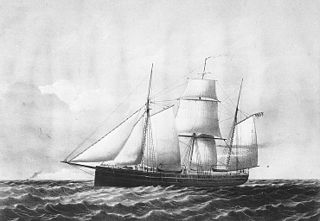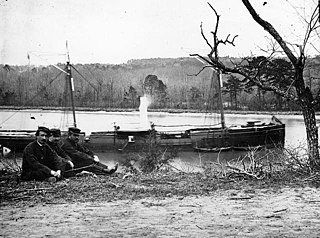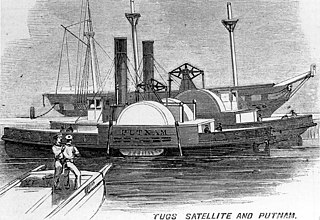
The first USS Sassacus, a wooden, double-ended, sidewheel steamer in commission in the United States Navy from 1863 to 1865. She saw service in the American Civil War.
CSS Raleigh was a steam-powered Civil War casemate ironclad. She was fitted with a spar torpedo instead of an iron ram and was built in 1863–1864 by the Confederate States Navy at Wilmington, North Carolina. While she was being built her commander was Lieutenant John Wilkinson (CSN). She was put into commission on April 30, 1864 under the command of Lieutenant J. Pembroke Jones, CSN.

USS Stars and Stripes was a 407-ton steamer acquired by the U.S. Navy and put to use by the Union during the American Civil War.

The first USS Monticello was a wooden screw-steamer in the Union Navy during the American Civil War. She was named for the home of Thomas Jefferson. She was briefly named Star in May 1861.

USS Niphon was a steam operated vessel acquired by the Union Navy during the American Civil War. She was used by the Navy to patrol navigable waterways of the Confederacy to prevent the South from trading with other countries.

USS Kansas was a gunboat constructed for the Union Navy during the middle of the American Civil War. She was outfitted with heavy guns and assigned to the Union blockade of the waterways of the Confederate States of America. She was the first U.S. Navy ship to be named Kansas and was the first of a class of 836-ton screw steam gunboats. At war's end, she continued serving her country by performing survey work and defending American interests in Cuba until sold in 1883.

The first USS Gettysburg was a steamer in the United States Navy. The ship was built in Glasgow, Scotland, in 1858, named RMS Douglas, and operated by the Isle of Man Steam Packet Company in the United Kingdom between Liverpool, England, and Douglas on the Isle of Man until November 1862. She was then sold to Cunard, Wilson & Company on behalf of the Confederate agents Fraser, Trenholm & Company for use by the Confederate States of America during the American Civil War. Renamed Margaret and Jessie, she operated as a blockade runner until her capture by the Union on 5 November 1863. The ship then was commissioned into the Union Navy on 2 May 1864 as USS Gettysburg.

USS Unadilla was a Unadilla-class gunboat built for service with the United States Navy during the American Civil War. She was the lead ship in her class.

USS Aries was an 820-ton iron screw steamer built at Sunderland, England, during 1861–1862, intended for employment as a blockade runner during the American Civil War. She was captured by Union Navy forces during the Union blockade of the Confederate States of America, and was commissioned as a Union gunboat. Aries was named for the constellation.

USS Howquah was a screw steamer purchased by the Union Navy in Boston from G. W. Upton on 17 June 1863, for action against Confederate commerce raider CSS Tacony which was then preying upon Northern merchantmen during what Professor Richard S. West has called "the most brilliant daredevil cruise of the war."
The USS Governor Buckingham was a hermaphrodite brig in the United States Navy during the American Civil War. The ship was built under contract by Messrs Maxon Fish & Co., Mystic, Conn., and was offered for sale to the Navy while on the ways; purchased at Stonington, Connecticut, 29 July 1863 by Isaac Henderson for $110,000; delivered at New York Navy Yard 30 September 1863; and commissioned 13 November 1863, Acting Volunteer Lt. W. G. Saltonstall in command. She was assigned to the North Atlantic Blockading Squadron, with instructions to report at Hampton Roads to Acting Rear Admiral S. P. Lee. The ship was probably named for the Governor of Connecticut, William Alfred Buckingham.

USS Young America was a Confederate steamer captured by the Union Navy’s blockade vessels, and subsequently placed in-service in the Union Navy during the American Civil War.

USS General Putnam – also known as the USS William G. Putnam – was acquired by the Union Navy during the first year of the American Civil War and outfitted as a gunboat and assigned to the Union blockade of the Confederate States of America. She also served as a tugboat and as a ship's tender when so required.
USS Berberry was a steam-powered tugboat acquired by the Union Navy during the American Civil War. She was used by the Navy to patrol navigable waterways of the Confederacy to prevent the South from trading with other countries.
USS Iron Age was a steamer acquired by the Union Navy during the American Civil War. She was used by the Navy to patrol navigable waterways of the Confederacy to prevent the Confederates from trading with other countries.
The first USS Calypso was a steamer captured by the Union Navy during the American Civil War.
USS Britannia was a steamer captured by the Union Navy during the American Civil War. She was used by the Union Navy as a gunboat and patrol vessel in support of the Union Navy blockade of Confederate waterways.
USS State of Georgia was a large steamer with powerful guns acquired by the Union Navy during the American Civil War. State of Georgia, with her crew of 113 sailors and officers, was used by the Union Navy as a gunboat in its blockade of Confederate waterways.
USS Victoria was a steamer acquired by the Union Navy during the American Civil War.
The third USS Union was a heavy (1,114-ton) steamer with a powerful 12-inch rifled gun purchased by the United States Navy during the American Civil War.











